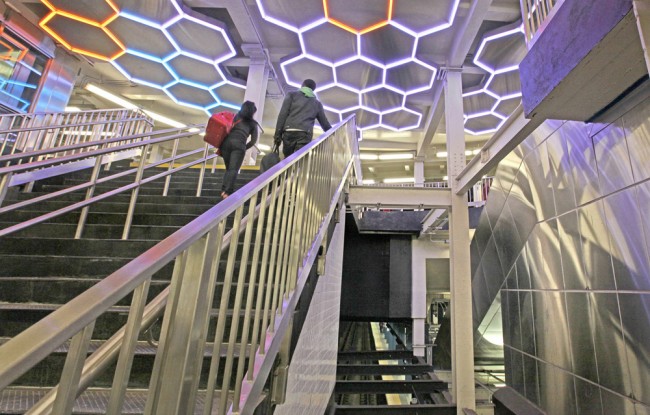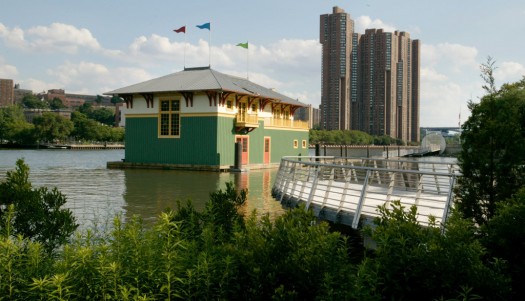
We are celebrating 15 years — and counting — of stories that are deeply researched and deeply felt, that build a historical record of what the city has been.
We are celebrating 15 years — and counting — of stories that are deeply researched and deeply felt, that build a historical record of what the city has been.
To mark the fifth anniversary of the launch of Urban Omnibus, we look at themes that have emerged in our content over time and think about what those threads reveal about the needs, desires, and priorities of the city today.
With a host of viable modes to move about the city and many places to go, New Yorkers are often more preoccupied with transportation than where it actually takes them. Just as neighborhoods can define identities, your go-to subway line may hold a dear place in your heart. And people who bike or consistently drive are often grouped together, as if transportation choices reveal their most salient traits. But beyond identity, our transportation networks also reveal intersecting political jurisdictions, the process of large-scale planning, changing technologies, economics, real estate development, and the places they connect.

Hive (Bleecker Street), 2012 © Leo Villareal, Bleecker Street/Lafayette Street Subway Station. Commissioned and owned by Metropolitan Transportation Authority Arts for Transit and Urban Design | Photo by Rob Wilson.
The Metropolitan Transit Authority, a State agency, controls some of the most crucial transportation infrastructure in New York City: its subways, bus lines, and commuter rail. With so many people reliant on the system, the MTA faces a significant communications challenge when things do not go as planned. To interface with the public more effectively, the agency craftily utilizes short YouTube videos to show construction progress, disaster response efforts, and the people behind their work. For major projects causing more long-term disruptions, such as the construction of a new subway line, the MTA utilizes more robust, on-the-ground community engagement methods like the storefront Second Avenue Subway Community Information Center on the Upper East Side to inform residents of their work. The MTA also seeks to improve its customers’ experience in other ways: through its Arts for Transit program, the agency brings performances and visual art to all parts of its system, among them Leo Villareal’s Hive, which lights up the Broadway/Lafayette–Bleecker Street subway station in SoHo.
While politically distinct from the City, the MTA must still work alongside city government and other stakeholders to plan the future of its system. As part of a Center for Urban Pedagogy “Urban Investigation,” students explored the interaction between these players and the decision-making process behind the extension of the 7 line to Midtown West.

The Peter Jay Sharp Boathouse at Swindler Cove Park in Inwood, part of the Bronx River Greenway and developed by the State Department of Transportation and the New York Restoration Project | Photo courtesy of NYSDOT
And the MTA isn’t the only non-City political body with substantial influence over the transportation structures of the five boroughs. The State Department of Transportation’s Region 11 office oversees the FDR, the BQE, and the West Side Highway (among other roadways), and is also active in improving the surrounding areas through landscape architecture interventions and open space planning.
And as surely as New Yorkers check for service disruptions on their subway line, the status of these highways and the many streets of the city are monitored closely for gridlocks and accidents. We visited the City’s Department of Transportation’s Traffic Management Center to see how operators are able to control half of the city’s 12,400 traffic lights from an office in Long Island City, adjusting signal timing to account for snarls in the street grid and keeping traffic moving as smoothly as possible. In another video in our City of Systems series investigating complex urban systems, we take a look at the history of development on Staten Island as influenced by the construction of the Verrazano-Narrows Bridge.
Bridges, roads, rails, and tunnels are familiar elements of the transportation backbone of the city, sometimes giving the impression that these represent all the available options. As Steven Dale makes clear, there are others, among them Cable-Propelled Transit that far outperforms New York’s own Roosevelt Island Tram and serves other major cities well. And as Robin Chase, founder of Zipcar, articulated back in 2009, reimagining how we use existing assets can be as revolutionary as new infrastructures and technologies.
Stations that connect distinct transportation systems — like Grand Central Terminal and Atlantic Terminal — are particularly complex and crucial points for moving about the city and region. We walked around Grand Central with Vishaan Chakrabarti, who explained why the terminal works from design, economic, and city planning perspectives. And in one of our Omnibus Meet-ups, we took to the tunnels of the newly renovated Atlantic Avenue–Pacific Street subway station (now Atlantic–Barclays Center) to see how two formerly distinct subway systems were knitted together.
As with many technologies, our transportation infrastructure sometimes breaks or becomes obsolete. For New York’s old subway cars, however, this does not mean the end of life. As Stephen Mallon depicts in his photo series Next Stop Atlantic, they are happily sitting at the bottom of the sea, soaking up their new roles as artificial reef substrates that can revitalize underwater neighborhoods.
The views expressed here are those of the authors only and do not reflect the position of The Architectural League of New York.